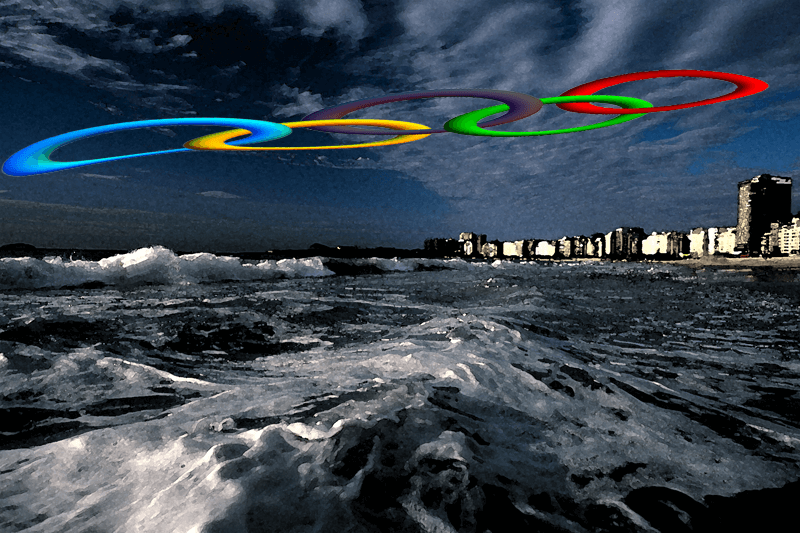New Testing On Rio Olympic Waters Shows Pollution To Be Widespread

Editorial Coverage Sponsored By FINIS
In the ongoing controversy over the safety of the open water venues at the 2016 Rio Olympic Games site in Rio de Janeiro, new testing sheds more light on the extent of the pollution in those waters. A report by The Associated Press shows that Rio de Janeiro’s water offshore is just as infested with dangerous pathogens as they are near land. The waters close to the city have already been shown to be highly contaminated, as raw sewage drains into them from storm drains and other polluted rivers.
Kristina Mena, an associate professor of public health at the University of Texas Health Science Center at Houston and expert in waterborne viruses, commented on the water quality to The Associated Press: “Those virus levels are widespread…It’s not just along the shoreline, but it’s elsewhere in the water. Therefore, it’s going to increase the exposure of the people who come into contact with those waters. We’re talking about an extreme environment, where the pollution is so high that exposure is imminent and the chance of infection very likely.”
Mena stressed that this environment was highly dangerous for anyone who would enter contact with the water, stating that: “The levels of viruses are so high in these Brazilian waters that if we saw those levels here in the United States on beaches, officials would likely close those beaches.”
Throughout the past year Swimming World has reported the controversy surrounding the aquatic venues in Rio, including reports from Greenpeace and other media outlets that the waters are unsafe for competition, and this most recent study is sure to add more fuel to the fire. The AP’s most recent tests demonstrate that the pollution is far more widespread than previously believed and that there has been no significant change in water quality since its tests back in July. In Guanabara Bay (nearly a kilometer from shore where the sailing competition will take place) the number of viruses found is the same as those found closer to sewage sources along the shore.
This new research indicates that the waters that swimmers and sailors would equally be at risk for infection in Rio’s contaminated waters. A pre-Olympic rowing and sailing event back in August has already shown to lead to illness in athletes at an alarming rate.
Despite the controversy and the increased attention on the dangerous levels of pollution in the water, organizers for the 2016 Games have denied the severity of the pollution in the water. In a statement sent to the AP via e-mail, the Rio 2016 Olympic organizing committee stated that: “The health and safety of athletes is always a top priority, and there is no doubt that water within the field of play meets the relevant standards. Rio 2016 follows the expert advice of the World Health Organization, whose guidelines for Safe Recreational Water Environments recommend classifying water through a regular program of microbial water-quality testing.”
Currently, Brazilian, World Health Organization, and Olympic officials are only asking Brazil to test for bacterial markers of pollution to determine water quality, which would not pick up on the high level of viruses shown in the AP’s testing. Members of the scientific communities across the United States and Europe are calling for legislation that would require stricter testing of the Olympic waters, including testing for the viruses that are being found in high quantities in the water.
Part of Rio’s bid to host the Olympics was based on a robust bid document that pledged to improve the city’s sewage sanitation, which Brazilian officials now acknowledge will not be able to happen before the Olympic Games.
With the Olympics less than a year away, these findings are significant to anyone who would be competing in the waters around Rio. Mena has stated that none of the venues would be fit for boating or sailing events, as athletes who ingest only three teaspoons of water would have a 99 percent chance of being infected by viruses.


- OFFICIAL SITE FOR RIO
- RIO COMPETITION SCHEDULE
- WHERE TO WATCH LIVE VIDEO OF OLYMPICS
- USA MEN'S SWIMMING TEAM
- USA WOMEN'S SWIMMING TEAM
- USA DIVERS GOING TO RIO
- USA WOMEN WATER POLO TEAM
- SWIMMING MEDAL PREDICTIONS
- FULL DAY 1 RESULTS
- FULL DAY 2 RESULTS
- FULL DAY 3 RESULTS
- FULL DAY 4 RESULTS
- FULL DAY 5 RESULTS
- FULL DAY 6 RESULTS
- FULL DAY 7 RESULTS
- FULL DAY 8 RESULTS
- WOMEN'S 10K OPEN WATER RESULTS
- MEN'S 10K OPEN WATER RESULTS
- FULL OLYMPIC SWIMMING RESULTS




Disgusting and dangerous!
I have swum all around the world, including in Rio de Janeiro’s Copacabana Beach. I have swum in Copacabana Beach at least 30 times for at least 30 minutes each time over the last 5 years – testing the waters on a first-hand basis for at least 3 days during each visit over the last 5 years. My personal experiences swimming in all kinds of conditions (rain, cold, warm, sunny, tranquil, wavy, morning, afternoon, evening) around the Olympic 10K Marathon Swim course and up and down the coastline of Copacabana Beach have been completely different than the information and predictions reported by Professor Mena and the AP. I swam in swim briefs and without ear plugs, swim caps and a wetsuit each time and never experienced a rash, vomiting or illness even though I have spotted and swum through urban runoff (i.e., floating debris) a few times during those dozens of ocean swims.